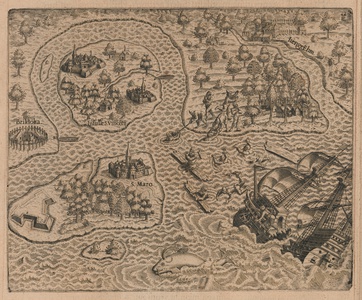| Method | Copper engraving |
| Artist | Theodor de Bry |
| Published | [Amsterdam, 1593] |
| Dimensions | Image and Plate 161 x 197mm, Sheet 323 x 230 mm |
| Notes |
A view depicting the shipwreck of Hans Staden during his trip to Brazil, from part three of the monumental Grande Voyages by Theodore De Bry. The scene was described in text on the following page: 'From Florianopolis the ships sailed northwards, eventually running into a fierce storm. On trying to land at an unknown harbour, their ship was wrecked and many of the crew had to cling to floating debris before being washed ashore. Eventually they reached the nearby settlement of Itanhaem on the island of Sao Vincente, from where Staden later became a gunner at the fort of Bertioga, near the port of Santos.' Hans Staden (c.1525- c.1576) was a German soldier and explorer. He made two trips to Brazil, the first in 1547 to October 1548. Staden enlisted on a second trip in March 1549 to Rio de la Plata. It was on this second journey that, upon reaching the mouth of the river, the ship he was on was wrecked. Eventually reaching land and the Portuguese settlement, Staden was hired as a gunner. Some weeks later he was captured by the Tupinambá people. Eventually he escaped and returned to Europe where he wrote his very successful Warhaftige Historia und beschreibung eyner Landtschafft der Wilden Nacketen, Grimmigen Menschfresser-Leuthen in der Newenwelt America gelegen: True History: An Account of Cannibal Captivity in Brazil. The account elicited great interest amongst European audiences, predominantly for describing the cannibalistic activities of the Tupinambá. Theodor de Bry (1528-1598) was a Flemish-born engraver and editor, who travelled Europe. De Bry fled from Liège in fear of the Spanish persecution of Protestants, lived in Strasbourg, travelled to Antwerp, then London, and finally settled in Frankfurt-am-Main, where he started a publishing business and printing workshop. de Bry's seminal work The Great and Small Voyages drew together contemporary narratives of exploration. Inspired and encourged by the English author Richard Hakluyt, de Bry completed the first part in 1590, and went on to publish five further parts before his death in 1598, when his wife and sons, Johann Theodor and Johann Israel, took over the task of completing the series. Immediately popular, drawing together a huge amount of material and in many cases providing the first readily available imagery of the new world and its inhabitants, this work and its illustrations provided the iconography and narrative of the peoples and customs of the Americas and the New World. The illustrations in the Voyages were in many cases based on existing images, but in many cases the images were altered to reflect European conventions, giving native peoples classical proportions and attributes. Condition: Manuscript borders in red ink in old hand to margins of sheet. Minor uniform time toning to sheet. Latin letterpress title above and descriptive text on verso. |
| Framing | unmounted |
| Price | £225.00 |
| Stock ID | 52621 |

